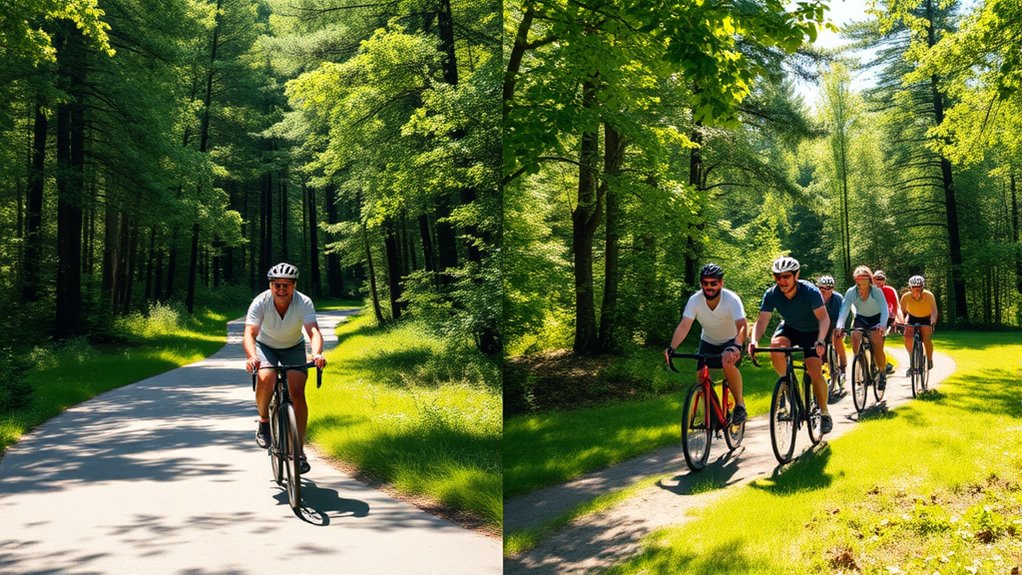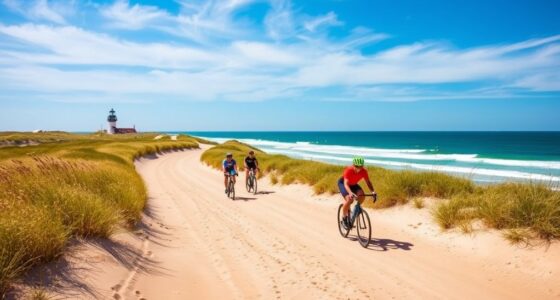When deciding between cycling solo or joining group rides, consider your goals and preferences. Solo rides offer you the freedom to choose your pace and route, letting you focus on personal growth and mental clarity. Group rides, on the other hand, provide camaraderie, motivation, and safety in numbers. Balancing both styles can enhance your cycling experience. Each has its unique advantages, and you’ll discover more about how to find the right fit for you.
Key Takeaways
- Solo cycling offers unmatched freedom to choose routes and change plans spontaneously without the influence of group dynamics.
- Group rides foster camaraderie and motivation, enhancing accountability through shared experiences and collective goals.
- Consider personal goals; solo rides allow for tailored training, while group rides simulate competitive environments for performance enhancement.
- Weather flexibility is a key advantage of solo rides, enabling adjustments based on conditions, unlike the fixed schedules of group rides.
- Striking a balance between solo and group rides maximizes training effectiveness while enjoying social interaction and support from fellow cyclists.
The Freedom of Solo Cycling
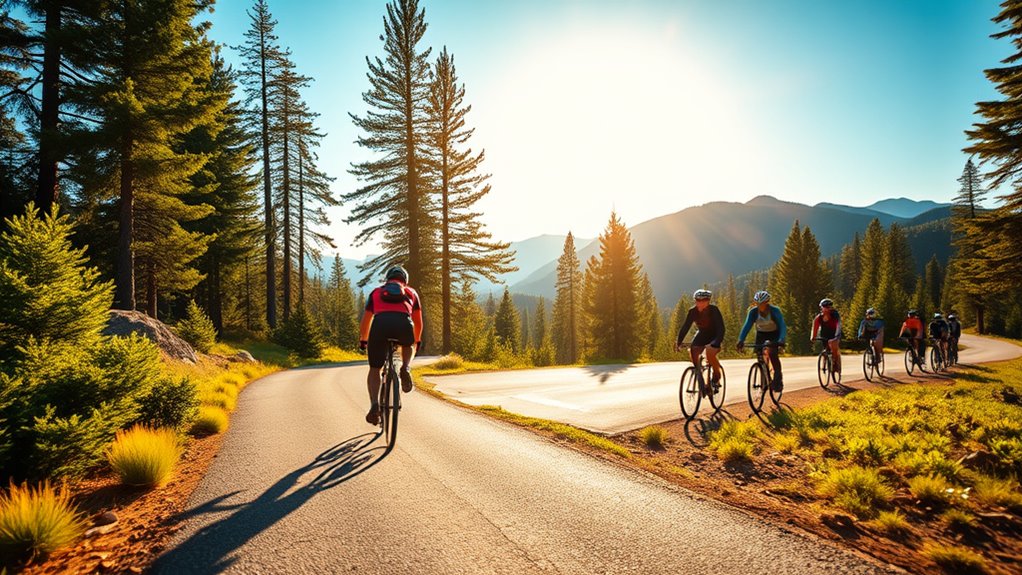
Solo cycling grants you unparalleled freedom, allowing you to choose your own route and make spontaneous changes as you ride.
When you ride alone, you can dictate your own pace, free from the pressure of keeping up with a group. This flexibility lets you set off at your preferred time, avoiding any delays from coordinating with others.
As you pedal through different landscapes, you’ll find opportunities for mental clarity and personal reflection, enhancing your experience.
The independence of solo cycling fosters self-reliance and encourages personal growth, as you connect deeply with your training objectives.
Embrace the freedom to explore at your own rhythm, challenge yourself physically, and enjoy the journey without external distractions. Additionally, the experience can be enriched by incorporating local culinary experiences from nearby eateries, making your rides even more delightful.
The Social Aspects of Group Rides
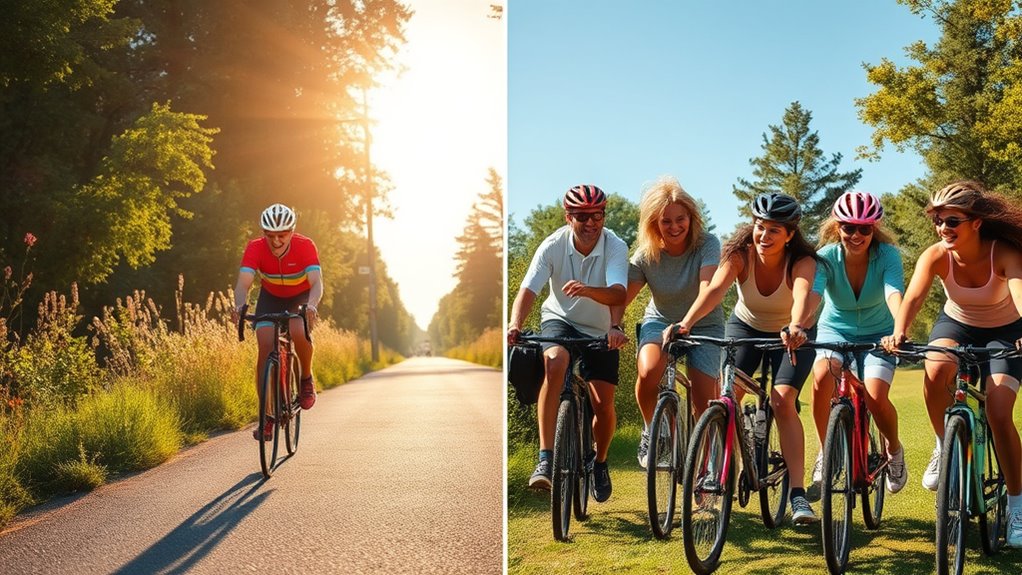
While solo cycling offers unmatched freedom, group rides bring a different kind of joy that thrives on social interaction. When you ride with others, you experience:
- Camaraderie: Build lasting friendships with fellow cyclists who share your passion.
- Motivation: Hold each other accountable, pushing your limits in a supportive environment.
- Shared Experiences: Enjoy stops for refreshments and relaxation, catering to various preferences.
- Sense of Belonging: Combat feelings of isolation and enhance your cycling experience with a community.
These elements create memorable moments during group rides, where shared challenges and achievements strengthen bonds among participants. Additionally, participating in group rides can also align with sustainable tourism practices, enhancing your travel experiences while promoting eco-friendly habits.
Mental Benefits of Riding Alone
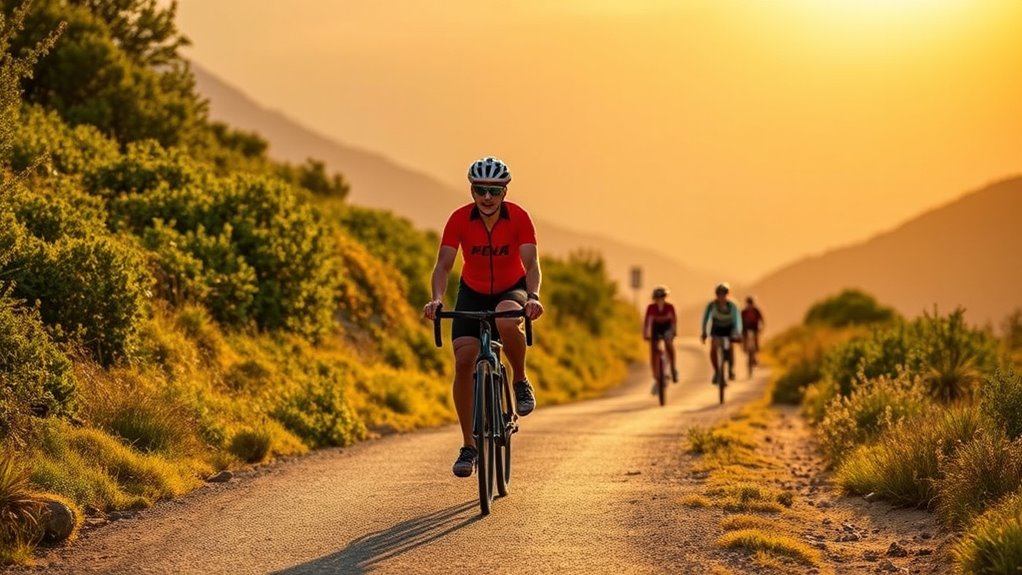
Riding alone offers a unique chance for personal reflection and mental clarity. With no distractions, you can process your thoughts and connect deeply with your surroundings. This solitude not only enhances your ride but also allows you to achieve a greater sense of freedom and accomplishment. Additionally, the experience can be likened to the benefits of solar energy systems, which provide sustainable and efficient power solutions while allowing individuals to connect with nature.
Personal Reflection Opportunities
When you choose to ride alone, you open the door to a unique opportunity for personal reflection that’s hard to find in group settings.
Solo riding allows you to immerse yourself in nature, providing a perfect backdrop for mental clarity. Here are some benefits you can experience:
- Clear Your Mind: Absorb your surroundings without distractions, enhancing your focus.
- Dictate the Pace: Ride at your own speed, allowing you to connect with your thoughts.
- Personal Challenges: Set goals like Strava PBs, boosting self-confidence through achievement.
- Escape Stressors: Enjoy solitude and embrace the freedom that comes with it.
These moments of reflection can lead to increased happiness and a deeper connection with cycling. Moreover, engaging in these solitary rides can foster curiosity and happiness, enhancing your overall experience and satisfaction with the activity.
Enhanced Mental Clarity
Cycling solo not only offers a chance to explore new routes but also greatly enhances your mental clarity. When you ride alone, you can escape daily stressors, allowing your mind to clear as you soak in the scenery.
This solitude fosters a deeper connection with your bike and the environment, boosting your overall enjoyment. You dictate your pace and route, leading to a heightened sense of freedom and personal achievement.
Without group distractions, you can focus on your form and technique, building mental resilience and self-reliance in reaching your goals. These uninterrupted moments let you absorb your surroundings, appreciate nature, and ultimately enhance your mental well-being, creating a tranquil riding experience that’s uniquely yours. Additionally, engaging in activities like cycling can lead to long-term energy savings, which contributes to lower utility bills.
Skill Development Through Group Rides
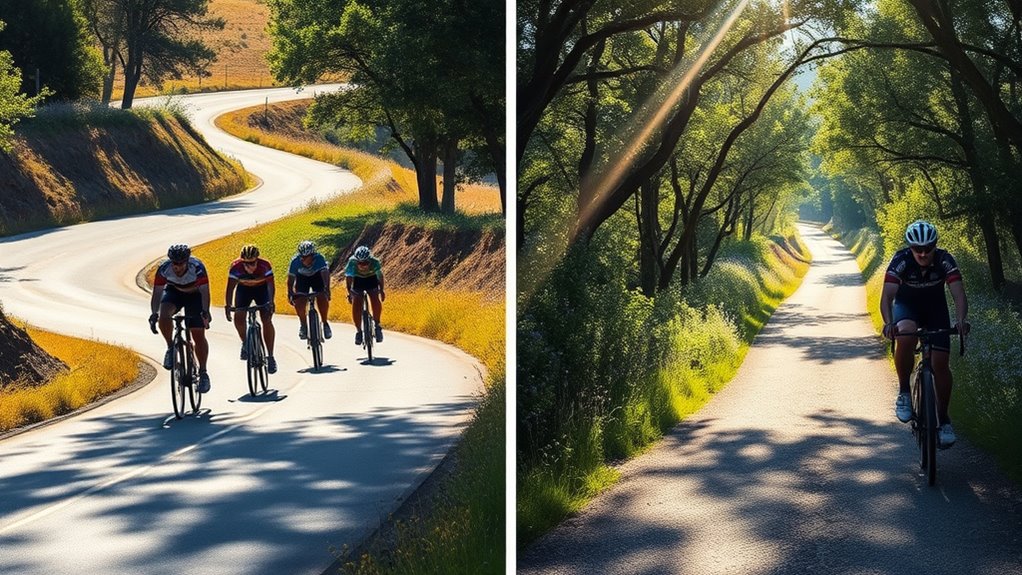
Group rides are a fantastic way to sharpen your bike handling skills, as you practice cornering and maneuvering with others.
You’ll also get to experience teamwork and strategy in action, simulating race conditions that enhance your performance.
Engaging with more experienced cyclists can help you learn valuable tactics and improve your overall efficiency on the road. Additionally, participating in group rides can enhance your financial health by promoting discipline and commitment in your cycling practice, much like maintaining a budget.
Enhanced Bike Handling Skills
Participating in group rides can considerably enhance your bike handling skills, as they provide a controlled environment to practice essential techniques.
When you ride in a group, you’ll benefit from:
- Improved Cornering: Practice cornering techniques alongside others to gain confidence.
- Pace Line Efficiency: Learn to ride effectively in pace lines, improving energy conservation.
- Learning from Stronger Riders: Observe and adopt techniques from more experienced cyclists.
- Close Riding Comfort: Get comfortable riding closely with others, vital for safety and performance.
Incorporating group riding into your training plan not only sharpens your bike handling but also prepares you for real-world racing conditions, making your overall cycling experience more enjoyable and effective. Additionally, mastering cornering techniques can significantly contribute to your overall performance in competitive scenarios.
Teamwork and Strategy Practice
While you might enjoy the freedom of solo rides, engaging in group outings can greatly sharpen your teamwork and strategy skills. When you ride together, you’ll learn to adapt to different roles, manage pressure, and execute strategic maneuvers. Group dynamics enhance your understanding of pace lines, improving efficiency and speed through drafting. Additionally, participating in group rides can simulate software development life cycle scenarios, allowing you to better strategize in competitive situations.
| Skill Development | Benefits of Group Rides | Key Takeaways |
|---|---|---|
| Teamwork | Enhances collaboration | Learn to work with others |
| Strategic Thinking | Simulates race conditions | Develop race tactics |
| Pressure Management | Encourages pushing limits | Balance training with tactics |
Participating in group rides fosters skill development under competitive scenarios, allowing you to improve both performance and teamwork.
Personal Goals vs. Group Dynamics
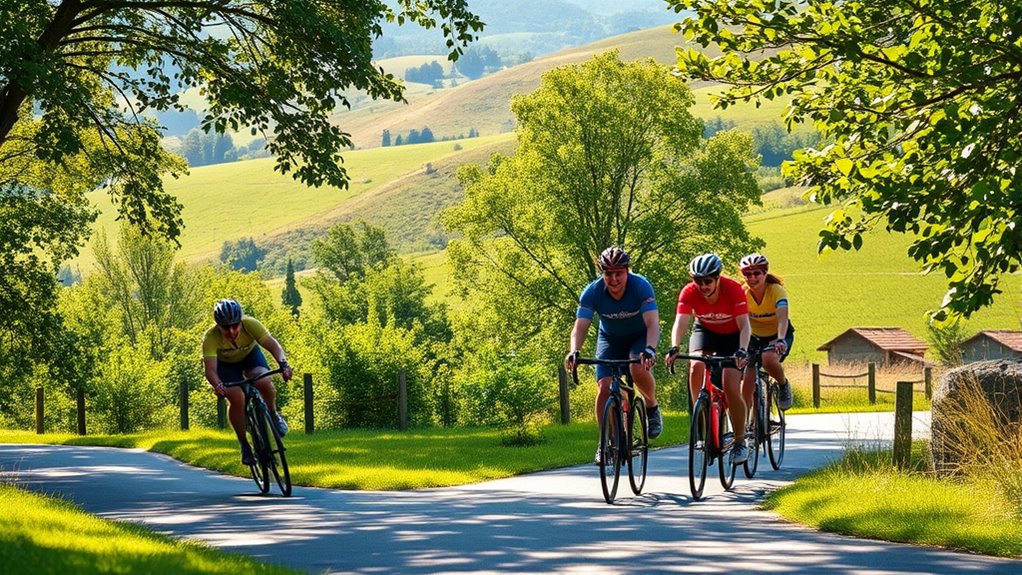
When you train alone, you can concentrate fully on your personal goals, honing your mental toughness and self-reliance without the distractions of group dynamics.
Here’s how riding solo and joining a group ride differ:
- Focus on Personal Goals: Tailor your training to your specific needs and objectives.
- Mental Toughness: Develop self-reliance and resilience without external pressures.
- Competitive Environment: Group rides simulate racing conditions, enhancing your tactics and strategies.
- Increased Intensity: Benefit from drafting and the camaraderie of fellow cyclists, boosting your speed by 2-3 mph.
Balancing solo rides and cycling club participation allows you to maximize performance, focusing on personal growth while gaining essential skills through group dynamics. Additionally, the experience of emotional intelligence gained from group interactions can enhance your overall cycling journey.
Weather Considerations for Each Riding Style
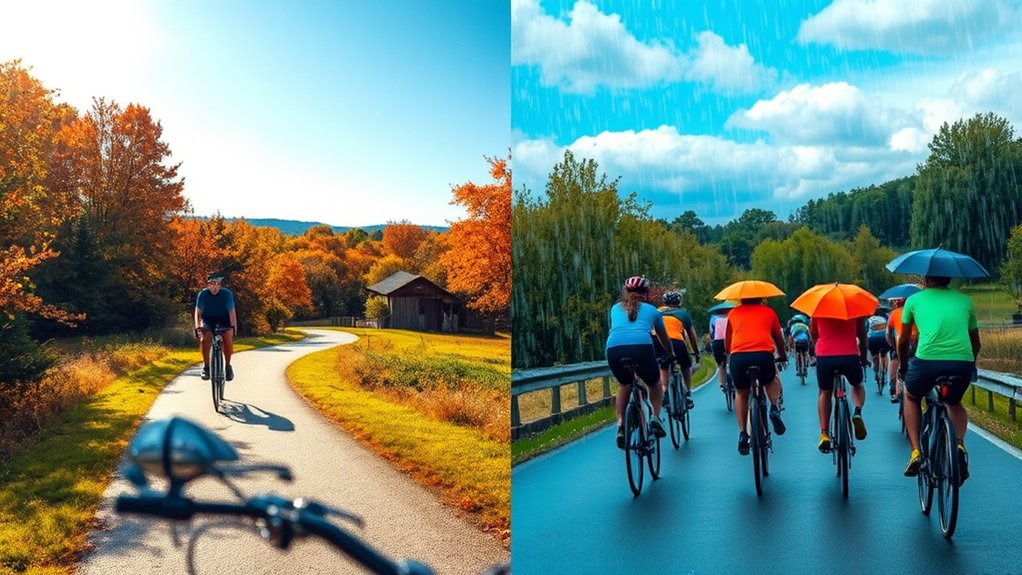
Choosing between solo rides and group rides often hinges on weather conditions, as each style has its own advantages in different climates.
When riding solo, you can pick your departure times and avoid unfavorable weather, ensuring comfort. In contrast, group rides require scheduling meet-ups, which might force you into poor weather.
During extreme temperatures or adverse conditions, riding solo can help you maintain control and focus. However, group rides can enhance safety during specific seasons, like magpie swooping season, where a riding partner can deter aggressive birds.
Keep in mind that while group rides often ramp up intensity, it may be less appealing in bad weather, making solo rides a better choice for adjusting your pace and duration. Additionally, being aware of environmental considerations can help you prepare for unexpected weather changes during your rides.
Finding the Right Balance for Your Riding Experience

Finding the right balance between solo and group rides can greatly enhance your cycling experience. To maximize your performance, consider these key points:
- Ride Solo: Focus on personal growth and enjoy mental clarity, which can account for 95% of your training.
- Join Organized Group Rides: Experience social interaction and motivation, boosting your average speed by 2-3 mph through drafting.
- Find Compatible Partners: Confirm your riding companions have similar abilities to maintain the ride’s flow and meet training goals.
- Mix It Up: Aim for at least one group ride per week to enjoy camaraderie while still benefiting from focused solo workouts.
Frequently Asked Questions
What Is the 80% Rule in Cycling?
The 80% Rule in cycling suggests you should spend 80% of your training time at a lower intensity, allowing for recovery and adaptation.
This means only 20% of your workouts should be high-intensity efforts. By following this guideline, you’ll improve your aerobic capacity and endurance while reducing the risk of injury.
Balancing your training in this way helps you build a strong foundation for performance gains without overtraining.
What Is the 75 Rule in Cycling?
Imagine a painter blending colors on a canvas, using 75% soft hues to create a beautiful backdrop while reserving the bold strokes for highlights.
That’s the essence of the 75 Rule in cycling. You’ll focus 75% of your training on lower-intensity rides to build endurance, leaving 25% for high-intensity efforts that sharpen your skills.
This balance keeps you energized, reduces injury risk, and boosts your overall performance while making the journey enjoyable.
What Is the Difference Between Solo and Group Rides?
When considering the difference between solo and group rides, think about your preferences.
Solo rides offer you the freedom to choose your route, pace, and schedule, allowing for a more personalized experience.
On the other hand, group rides enhance your skills and provide a support network, making workouts more intense with shared energy.
Both options have unique benefits, so it’s up to you to decide which aligns better with your cycling goals and style.
What Body Shape Does Cycling Give You?
Cycling’s like sculpting your body with every pedal stroke. As you ride, you’ll strengthen your lower body muscles, creating toned legs and a firmer backside.
With regular cycling, your cardiovascular fitness improves, helping you shed fat, especially around your waist. You’ll notice increased muscle endurance and a leaner physique, along with a more defined core.
Over time, cycling can even give you that enviable V-shape, especially if you mix in some upper body strength training.
Conclusion
So, whether you’re racing against the wind solo or steering through the chaotic ballet of a group ride, remember: cycling’s all about you. Picture yourself as a lone wolf howling at the moon or a jester juggling wheels in a circus. Choose your path wisely! Embrace the freedom of the open road or the camaraderie of shared snacks and stories. Ultimately, it’s about enjoying the ride—just don’t forget the sunscreen, unless you fancy a lobster look!
